4 ways lift truck operator training is evolving
Some elements of training programs are a must, like the need for hands-on instruction, but lift truck OEMs are evolving training in areas like providing smaller chunks of classroom content and training people to support deployment of autonomous trucks.

Lift truck operator training will always have constant elements. Even with virtual reality (VR) technology and digital meeting tools like Zoom or Teams, hands-on instruction remains a required element of any operator training program.
Some on-the-truck instruction is a must, but above that, plenty of change exists in how training is presented and evolving. Four evolutions are: more use of bite-sized content; training considerations with autonomous trucks; interest in training on specific trucks and functions; and a higher comfort level with remote and digital training approaches, post pandemic.
1 Bite-sized content
Classroom training and videos are shifting toward being shorter, bite-sized pieces of content, notes Jason Moore, a trainer with Hyster Company.
“One thing we’ve done is to make our training videos shorter, so operators can take in little pieces of information at a time,” Moore says. “With shorter videos, it allows for more interaction with the instructor, which keeps everyone engaged. It also allows the instructors to easily pick out those pieces of training they want to present.”
Jim Gaskell, director of global automation and emerging technologies for Crown Equipment, agrees that smaller chunks of training content, followed up by instructor verification of learned skills, is a trend.
Crown calls its approach “Demonstrated Performance” training, says Gaskell, and the intent is to blend smaller segments of study followed by a quick test of what was learned.
“Instead of lecture-based training where you may sit in a classroom for an hour, you are learning in bite-sized pieces and then actually demonstrating that you can get from Point A to Point B successfully,” says Gaskell.
2 Autonomy & training
The increasing use of autonomous lift trucks also ties into training. For one thing, says Moore, someone needs to be trained on how to start up and perform safety checks on autonomous trucks, and that person should know the fleet software well enough to monitor fleet performance and resolve any alerts or issues, such as a sensor that might need cleaning.
“Autonomous units aren’t going to make mistakes like crashing into something, but you still need to have someone who is trained in overseeing the fleet,” says Moore.
Gaskell points out that as organizations begin to rollout more autonomous lift trucks, former lift truck operators make ideal supervisors for the autonomous assets, because they can operate a dual-mode autonomous truck if needed and also know pallet workflows and load characteristics.
“[Our customers] would usually pick skilled operators for that role because if a situation arose where they needed to intervene, they already know how to operate the equipment,” Gaskell says.
In cases where the real-time traffic manager software for an automated systems is run on-premise behind a firewall with no external data access allowed, telematics can serve as a bridge to obtain data on fleet trends and events, says Gaskell.
Similarly, he adds, looking at telematics data can indicate to managers whether more training might be needed for operators on equipment with semi-autonomous functions such as remote order picking, because the telematics solution will detect how often the remote-order pick functionally is being used.
If the telematics show the semi-autonomous functions aren’t being used much, and an operator’s throughput is lagging, it could indicate the operator needs refresher training on the remote order pick function, or at least a discussion is warranted as to why the function is not being engaged.
3 Functional focus
Moore adds that Hyster is producing more multi-media content aimed at specific truck models and features, since user organizations want to ensure operators are mastering the capabilities of certain trucks. “We’ll have customers who’ll say, what do you have for videos specific to our turret trucks, or reach trucks, so we are working on expanding that type of content,” says Moore.
While safety training is part of any good training program, adds Moore, training should also cover the points of ergonomic adjustment on a vehicle, with the aim of making operators more comfortable. “Any good training program is going to cover those adjustability points on the trucks because if you have operators who are comfortable, that’s going to contribute to making them more productive,” Moore says.
4 Digital lessons
The early months of the pandemic threw a challenge at operator training programs because of site restrictions, but the industry adapted, says Moore, with OEMs working closely with dealers to ramp up access to remote training packages.
Hands-on testing posed a special challenge, since some companies didn’t want external trainers inside a warehouse. In some cases, says Moore, the hands-on training could be done outdoors by an external trainer, but in others, it was necessary to use a “train the trainer” approach to authorize more internal experts for hands-on testing and verification of skills.
Moore says that external trainers got very busy after pandemic restrictions eased up, but that overall, dealers and OEMs collaborated well to handle a higher volume of remote classroom training needs, while also proving the value of having good digital tools for remote training and classroom administration.
“The pandemic was challenging for us all, but now if something similar happens, we know what works well, and which tools we can apply,” says Moore.

Article Topics
Training News & Resources
60 Seconds with Kim Douglass of Toyota Material Handling 60 Seconds with Sam Kurten, Engineering intern at Matrix, a ProMach product brand 4 ways lift truck operator training is evolving What’s your strategy to find/hire/train/retain techs? Resurge uses AI-style training tool Technology’s fit with training best practices Rutgers job training program for autistic adults gets boost from logistics company More TrainingLatest in Materials Handling
Registration open for Pack Expo International 2024 Walmart chooses Swisslog AS/RS and software for third milk processing facility NetLogistik partners with Vuzix subsidiary Moviynt to offer mobility solutions for warehouses Materials Handling Robotics: The new world of heterogeneous robotic integration BSLBATT is looking for new distributors and resellers worldwide Lucas Watson appointed CSO for Körber’s Parcel Logistics business in North America Hyster recognizes Dealers of Distinction for 2023 More Materials HandlingAbout the Author
Subscribe to Materials Handling Magazine

Find out what the world's most innovative companies are doing to improve productivity in their plants and distribution centers.
Start your FREE subscription today.
April 2024 Modern Materials Handling

Latest Resources











